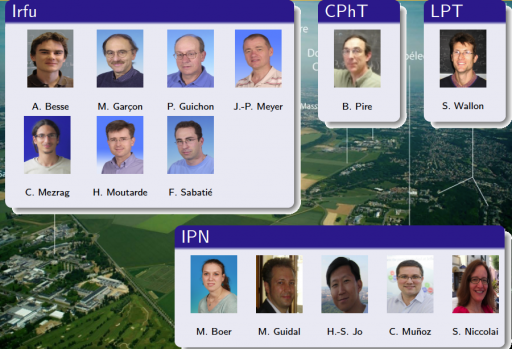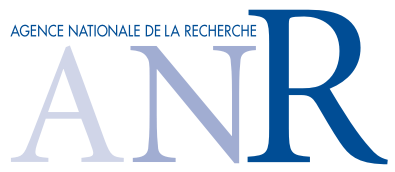Scientific program
The aim of this project is the realization of a software framework dedicated to the study of the structure of hadrons in terms of their elementary constituents, quarks and gluons. This tool is critical for the achievement of a long-range program at the intersection of particle and nuclear physics involving hundreds of scientists worldwide.
During the 1970’s, physicists worked out a successful formulation of the strong interaction, although this formulation is still mysterious in many respects. It is named Quantum Chromo Dynamics (QCD). According to this fundamental theory, strongly interacting particles (hadrons) are made up of quarks and gluons, collectively referred to as partons. Quarks and gluons are the degrees of freedom through which QCD is defined, but this theory describes all strongly interacting particles: hadrons and nuclei. A major question is thus to understand the emergence of the properties of hadrons (mass, spin, etc.) from the collective organization of partons.
During the second half of the 1990’s, theorists exhibited the promising new theoretical concept of a Generalized Parton Distribution (GPD). For the first time in seventy years of study of the proton structure occurred the possibility of a three-dimensional representation of its internal structure as well as a possible path to the resolution of long-standing issues such as the origin of the proton spin. Theorists also proposed several different ways to access GPDs experimentally: GPDs indeed parameterize some observables of specific processes in a theoretically robust but very involved way. These findings demonstrated the feasibility of experimental tomography of hadrons.
The first convincing experimental evidences (obtained in electromagnetic scattering on hydrogen targets) were collected in the early 2000’s and results of the first dedicated experiments were published in 2006 and 2007. However the completion of the GPD physics program requires very accurate measurements of a large number of different observables to allow a complete experimental determination of GPDs. This experimental work is expected to continue at least during the next 10 years at several international facilities, including (among others) the Thomas Jefferson National Laboratory (Jefferson Lab, or JLab) and the European Organization for Nuclear Research (CERN). These forthcoming years will be the time of unprecedented high precision measurements. GPD physics is also one key component of the physics case of a possible future Electron Ion Collider (EIC) at horizon 2025.
Our project has been designed to fulfill the needs of the worldwide hadronic physics community. Its architecture consist of the following tools:
• A comprehensive database of experimental results;
• A comprehensive database of theoretical predictions;
• A fast and efficient software to extract GPDs from measurements of different observables of several specific processes;
• A robust strategy to propagate systematic and statistic uncertainties to the extracted GPDs, and to evaluate systematic uncertainties on GPD parametrizations;
• A visualisation software to compare experimental results and model expectations;
• An interface to connect the previous items to different experimental set-up descriptions to design new experiments;
• An interactive web site providing a free access to model and experimental values of GPDs first to the whole hadronic physics community, and second to a broader audience (science popularization and illustrative examples of current research trends in high school and undergraduate teaching).
First high precision measurements are expected by 2014 at CERN. At that time the first phase of the physics program of Jefferson Lab will be completed, and the second phase about to start. The release of the software components described here will be the suitable facility to take the next step to resume the physics program.

Project members. The four partners involved in the PARTONS project are Irfu (SPhN and SPP), IPN Orsay, CPhT (Ecole Polytechnique) and LPT Orsay.
Project members and partners
- BERTHOU, Bryan
- GARCON, Michel
- GUICHON, Pierre
- MEZRAG, Cédric
- MOUTARDE, Hervé
- SABATIE, Franck
- MEYER, Jean-Pierre
- PIRE, Bernard
- WALLON, Samuel
Publications
P. Kroll, H. Moutarde and F.Sabatié, From hard exclusive meson electroproduction to deeply virtual Compton scattering, Eur. Phys. J. C73 (2013) 2278 [arXiv:1210.6975 [hep-ph]].
H. Moutarde, B. Pire, F. Sabatie, L. Szymanowski and J. Wagner, On timelike and spacelike deeply virtual Compton scattering at next to leading order, Phys. Rev. D87 (2013) 054029 [arXiv:1301.3819 [hep-ph]].
M. Guidal, H. Moutarde and M. Vanderhaeghen, Generalized Parton Distributions in the valence region from Deeply Virtual Compton Scattering, Rep. Prog. Phys. 76 (2013) 066202 [arXiv:1303.6600 [hep-ph]].
B. Pire, K. Semenov-Tian-Shansky and L. Szymanowski, QCD description of charmonium plus light meson production in antiproton-nucleon annihilation, Phys. Lett. B724 (2013) 99 [arXiv:1304.6298 [hep-ph]].
C. Mezrag, H. Moutarde and F. Sabatié, Test of two new parameterizations of the Generalized Parton Distribution H, Phys. Rev. D88 (2013) 014001 [arXiv:1304.7645 [hep-ph]].
B. Pire, L. Szymanowski and S. Wallon, Chiral-odd pion generalized parton distributions beyond leading twist [arXiv:1309.0083 [hep-ph]].
B. Pire, K. Semenov-Tian-Shansky, L. Szymanowski and S. Wallon, Crossed channel analysis of quark and gluon generalized parton distributions with helicity flip, Eur. Phys. J. A50 (2014) 90, [arXiv:1403.0803 [hep-ph]].
L. Chang, C. Mezrag, H. Moutarde, C.D. Roberts, J. Rodriguez-Quintero and P. Tandy, Basic features of the pion valence-quark distribution function, Phys. Lett. B737 (2014) 23, [arXiv:1406.5450 [nucl-th]].
C. Mezrag, H. Moutarde, J. Rodriguez-Quintero and F. Sabatié, Towards a pion Generalized Parton Distribution model from Dyson-Schwinger equations, [arXiv:1406.7425 [hep-ph]].
C. Mezrag, L. Chang, H. Moutarde, C.D. Roberts, J. Rodriguez-Quintero, F. Sabatié and S.M. Schmidt, Skectching the pion's valence-quark generalised parton distribution, to appear in Phys. Lett. B, [arXiv:1411.6634 [nucl-th]].




